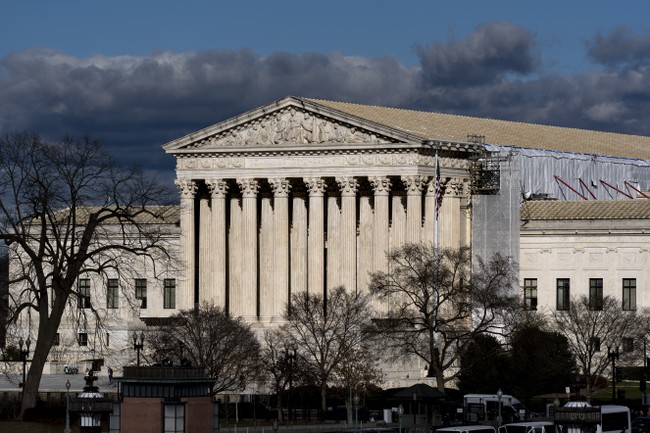
This article was originally published on Bearing Arms. You can read the original article HERE

In an 8-1 decision, the Supreme Court upheld Zachey Rahimi's conviction for possessing a firearm while subject to a domestic violence restraining order, holding that "when an individual has been found by a court to pose a credible threat to the physical safety of another, that individual may be temporarily disarmed consistent with the Second Amendment."
Advertisement
The majority opinion, authored by Chief Justice John Roberts, appears to open the door not only to bans on gun ownership for those subject to domestic violence restraining orders, but Extreme Risk Protection Orders as well. The Court held that while there was no "historical twin" to the statute in question at the time the Second Amendment was ratified, there are still enough appropriate "analogues" to uphold the statute.
Together, the surety and going armed laws confirm what common sense suggests: When an individual poses a clear threat of physical violence to another, the threatening individual may be disarmed. Section 922(g)(8) is not identical to these founding-era regimes, but it does not need to be. Like the surety and going armed laws, Section922(g)(8)(C)(i) applies to individuals found by a court to threaten the physical safety of another. This prohibition is “relevantly similar” to those founding era regimes in both why and how it burdens the Second Amendment right.
Roberts added that "while we do not suggest that the Second Amendment prohibits the enactment of laws banning the possession of guns by categories of persons thought by a legislature to present a special danger of misuse, we note that Section 922(g)(8) applies only once a court has found that the defendant 'represents a credible threat to the physical safety' of another." That at least leaves the door open for those convicted of non-violent felonies or non-violent misdemeanors punishable by more than a year in prison to regain their Second Amendment rights going forward, especially since the Court took note of the "temporary" nature of a restraining order, as opposed to the lifetime ban on possessing firearms that comes post-conviction.
Advertisement
Importantly, the majority opinion did shoot down one argument presented by the DOJ; the Second Amendment only applies to "responsible" citizens.
“Responsible” is a vague term. It is unclear whatsuch a rule would entail. Nor does such a line derive fromour case law. In Heller and Bruen, we used the term “responsible” to describe the class of ordinary citizens who undoubtedly enjoy the Second Amendment right. But those decisions did not define the term and said nothing about the status of citizens who were not “responsible.” The question was simply not presented.
In addition to the majority opinion and Justice Clarence Thomas's dissent, there were four concurring opinions released today; one from Justices Sonia Sotomayor and Elena Kagan, and separate concurrence from Amy Coney Barrett, Brett Kavanaugh, and Neil Gorsuch. [Editor's Note: a previous version of this story mistakenly said that Samuel Alito also authored a concurrence. We have corrected the error.]
Gorsuch's concurrence notes that today's decision "necessarily leaves open the question whether the statute might be unconstitutional as applied in“particular circumstances.”
So,for example, we do not decide today whether the government may disarm a person without a judicial finding that he poses a “credible threat” to another’s physical safety. We do not resolve whether the government may disarm an individual permanently. We do not determine whether§922(g)(8) may be constitutionally enforced against a person who uses a firearm in self-defense. Notably, the surety laws that inform today’s decision allowed even an individual found to pose a threat to another to “obtain an exception if he needed his arms for self-defense.” Nor do we purport to approve in advance other laws denying firearms on a categorical basis to any group of persons a legislature happens to deem, as the government puts it, “not ‘responsible.’”
Advertisement
We'll be delving more into the concurring opinions and Justice Thomas's dissent in subsequent posts, but given all of the media speculation that Justice Barrett was about to break with the conservative wing of the Court over the use of "history and tradition" to determine the constitutionality of gun laws, it's worth pointing out this key bit from her concurrence today.
In Bruen, the Court took history beyond the founding era, considering gun regulations that spanned the 19th century. I expressed reservations about the scope of that inquiry but concluded that the timing question did not matter to Bruen’s holding. It bears emphasis, however, that my questions were about the time period relevant to discerning the Second Amendment’s original meaning—for instance, what is the post-1791 cutoff for discerning how the Second Amendment was originally understood? My doubts were not about whether “tradition,” standing alone, is dispositive.
While that sounds like a positive stance for Second Amendment advocates, Barrett went on to make it clear that "imposing a test that demands overly specific analogues has serious problems," which could open the door to modern gun control laws being upheld based on the flimsiest of ties to 18th-century statutes.
As Gorsuch says, many questions regarding who can be stripped of their right to keep and bear arms, for how long, and for what reason remain unresolved by Rahimi. I'm concerned, however, that a majority of justices are ready to give pretty wide latitude to the states and Congress when it comes to answering those questions.
Advertisement
This article was originally published by Bearing Arms. We only curate news from sources that align with the core values of our intended conservative audience. If you like the news you read here we encourage you to utilize the original sources for even more great news and opinions you can trust!










Comments